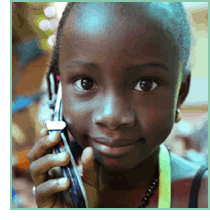Millward Brown’s POV, July 2009
What’s Next For Mobile?
While the world remains engulfed in an economic "Perfect Storm", the full potential of mobile marketing will not be achieved until a "Perfect Calm" occurs, in which the vision that mobile operators and marketers have for the mobile phone lines up with the reality of what the device means to consumers. As to when and how this may occur, emerging markets that are home to three in four of the world's mobile users may provide critical clues.

A "Perfect Storm" requires a certain confluence of events to transform something that is merely bad or unpleasant into a disaster. A "Perfect Calm" is no different, and a Perfect Calm is what is needed to fulfill the potential of the mobile phone as a branding and marketing platform. People everywhere - especially in developing markets - rely on their phones for communications, transactions, and the management of their personal business. But in treating mobile as just another marketing tool to be parked alongside TV, print, and online, marketers and Mobile Network Operators (MNOs) are undervaluing the potential of the channel. While there are many examples of effective mobile campaigns, some of which have been described in previous Millward Brown POVs,1 the development of mobile marketing will remain limited until MNOs and marketers recognize the significance of mobile phones to the lives of more than 3 billion people around the world.
| Mobile is both a media channel in which a brand can have a "share of voice" and a phenomenon that commands a "share of lifestyle." |
Among the developing regions, Africa provides an especially fascinating context in which to observe the evolution of mobile communication and marketing. Not only is the overall media infrastructure relatively underdeveloped on much of the African continent, but in many countries, more fundamental types of infrastructure are lacking. Roads, electrical lines, and other physical infrastructures exist only on a piecemeal basis, and offer uneven levels of quality and reliability. Thus in Africa, a unique situation exists: The mobile phone is Africa's only true Pan-African infrastructure. While some pay-TV networks do have Pan-African broadcasts, only the more affluent households receive them. Radio delivers considerable reach, but is fragmented and limited when compared to the one-to-one interactivity of mobile. And on a continent where scores of languages are spoken, mobile offers advanced targeting and segmentation possibilities.
Mobile phones have been instruments of transformation on the African continent, delivering not just communication but access to markets, health care information, and emergency services. Thus in the emerging markets of Africa, the mobile phone is both a media channel in which a brand has a "share of voice" and a phenomenon that commands a "share of lifestyle." This is also true, though to a lesser extent, in other more developed markets around the globe where people have come to rely on their mobiles for various lifestyle enhancements and diversions. This POV will seek to build on what we already know about mobile marketing and anticipate the ways in which marketers in Africa and elsewhere might capitalize on mobile as the most intimate, pervasive and engaging media channel yet devised.
Content:
- What We Know
- A Myopic Focus: Price
- The Bigger Picture
- Implications For Marketers
- Conclusion
Download the full report (pdf, 171kb)
To read more about marketing during recession, visit
www.mb-blog.com.
 www.millwardbrown.com
www.millwardbrown.com